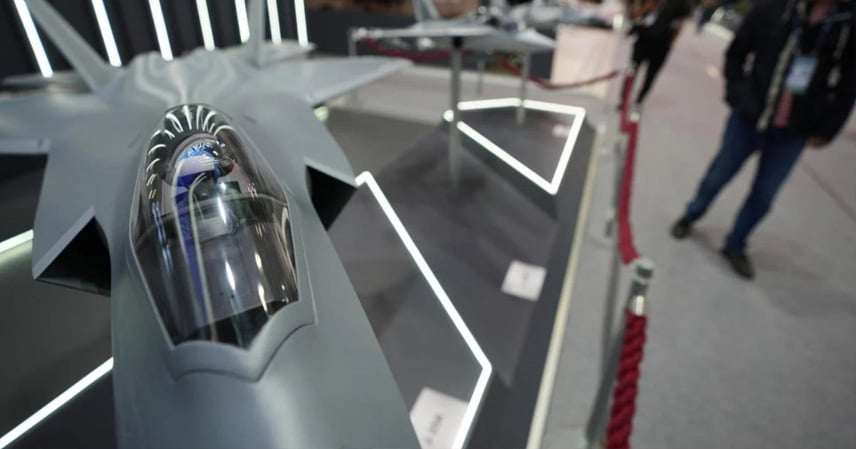At the “Partner-2025” International Defense Exhibition in Serbia, China’s J-35 stealth fighter jet model made its first public appearance in the heart of Europe, drawing wide attention from both domestic and international media.
This was not just a routine arms display. It carried profound historical symbolism: 26 years ago, the Chinese Embassy in Belgrade was bombed by the U.S. military, killing three Chinese journalists.
Now, the debut of a fifth-generation Chinese fighter jet model on the same soil served as a silent response and a powerful reminder: history is never forgotten, and national strength is quietly reshaping the global balance.
China’s Defense Industry “High Point”
If international defense expos are likened to a global “showroom,” then the Chinese exhibition stand became the centerpiece. Aviation Industry Corporation of China (AVIC) and NORINCO brought a lineup that looked more like an air show transported indoors:
- J-35A stealth fighter jet
- Y-20 strategic transport aircraft
- Z-20 utility helicopter
- Advanced air defense systems and unmanned platforms
The J-35’s first European debut held meaning far beyond the scale model itself. This twin-engine stealth carrier-based fighter is regarded as a cornerstone in China’s fifth-generation aircraft strategy, with stealth, avionics, and combat radius approaching the level of Western peers.
Beyond the model, the message was clear: China is no longer content with regional influence—it is steadily expanding its military presence into Europe’s backyard.
China’s booth also displayed more than 20 types of ground equipment, including the FK-3 air defense missile system, the HJ-12 anti-tank missile, and multiple drone combat platforms. Serbia has already procured the FK-3 system in 2023 to strengthen its air defense network, proving these systems are not just weapons, but also barometers of warming China-Serbia ties.
Wounds That Cannot Be Forgotten
On May 7, 1999, a U.S. B-2 stealth bomber launched precision-guided bombs at the Chinese Embassy in Belgrade, killing three Chinese journalists and injuring others. The U.S. later claimed it was caused by a “map error,” but this explanation was widely rejected in China.
At that time, China lacked aircraft carriers and stealth fighters, and could only endure the humiliation. Yet, that night became a turning point for China’s military modernization.
Analysts have noted that the incident accelerated China’s investment in stealth technology, satellite navigation, and intelligence systems. Experts emphasized the lesson: without strong military and technological power, there is no real international voice or security.
While some foreign media speculated China advanced its stealth programs by studying wreckage from the downed U.S. F-117A stealth fighter, such claims lack evidence. In reality, China’s J-20 and J-35 are the result of independent research and countless engineering breakthroughs—not scavenged scraps.
From Memory to Partnership
Instead of pushing China-Serbia relations into confrontation, the tragedy became a foundation for long-term cooperation. Over the past two decades, ties deepened across infrastructure, trade, and defense.
China has invested in railways, bridges, and power plants across Serbia, while military cooperation has included deliveries of FK-3 air defense systems, HQ-17A, CH-series drones, and radar systems. These deals not only boosted Serbia’s defense capacity but also gave Belgrade greater autonomy under NATO’s shadow.
Now, with the J-35 model unveiled in Belgrade, Serbian military representatives have shown genuine interest. This indicates potential procurement opportunities and highlights China’s rising competitiveness in the European arms market, where buyers once defaulted to U.S., French, or British suppliers.
A Message Beyond the Jet
The J-35 is more than an aircraft—it is a diplomatic message. China presents defense cooperation without political strings, military intervention, or imposed alliances, instead offering mutual benefit and trust.
Thus, the J-35’s presence in Serbia was no coincidence. It represented the intersection of memory and modern strength: the scars of 1999 remain, but today, China responds with technological achievement, not hostility.
China has not chosen hatred but self-empowerment; not confrontation, but cooperation. This is not forgetting—it is a more powerful way of remembering.
As the Chinese saying goes, “To remember history is to shape the future.” The wings of the J-35 now carry both national memory and aspirations for shared peace, soaring toward a new horizon of global influence.
References
- Xinhua News Agency reports on China-Serbia cooperation (2023)
- Public data from the Partner-2025 International Defense Exhibition



